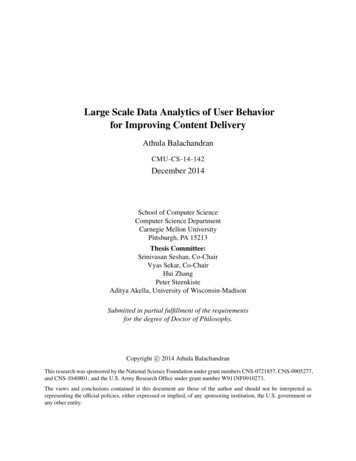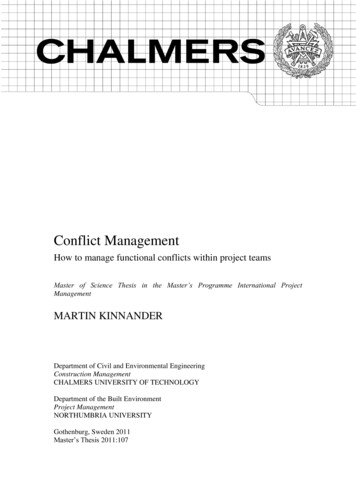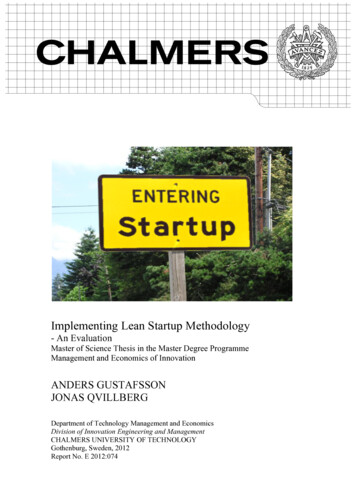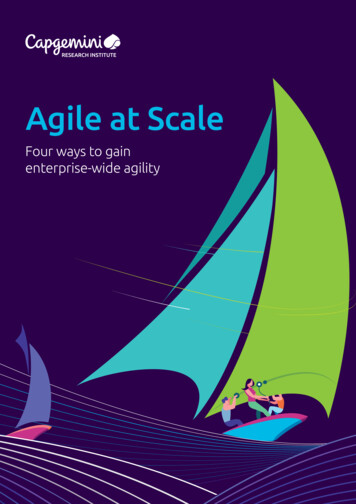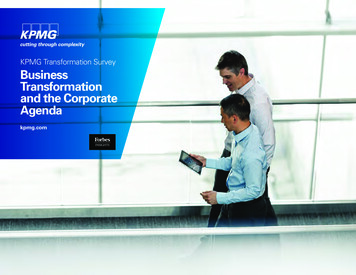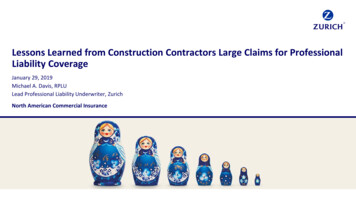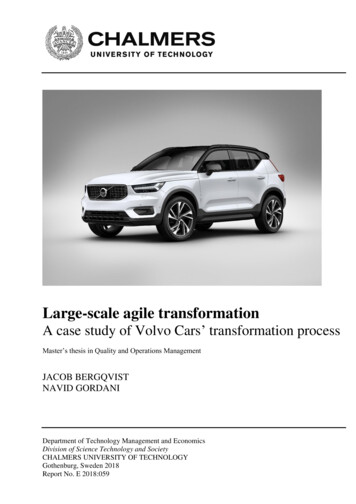
Transcription
Large-scale agile transformationA case study of Volvo Cars’ transformation processMaster’s thesis in Quality and Operations ManagementJACOB BERGQVISTNAVID GORDANIDepartment of Technology Management and EconomicsDivision of Science Technology and SocietyCHALMERS UNIVERSITY OF TECHNOLOGYGothenburg, Sweden 2018Report No. E 2018:059
MASTER’S THESIS E 2018:059Large-scale agile transformationA case study of Volvo Cars’ transformation processJACOB BERGQVISTNAVID GORDANIDepartment of Technology Management and EconomicsDivision of Science Technology and SocietyCHALMERS UNIVERSITY OF TECHNOLOGYGothenburg, Sweden 2018
Large-scale agile transformationA case study of Volvo Cars’ transformation processJACOB BERGQVISTNAVID GORDANI JACOB BERGQVIST, NAVID GORDANI, 2018.Supervisor: Sverker Alänge, Department of Technology Management and EconomicsExaminer: Sverker Alänge, Department of Technology Management and EconomicsMaster’s Thesis E 2018:059Department of Technology Management and EconomicsDivision of Science Technology and SocietyChalmers University of TechnologySE-412 96 Gothenburg, SwedenTelephone 46 (0)31-772 1000Cover: Volvo XC40, approved by Volvo Cars to be used as a cover picture.Chalmers ReproserviceGothenburg, Sweden 2018
Large-scale agile transformationA case study of Volvo Cars’ transformation processJACOB BERGQVISTNAVID GORDANIDepartment of Technology Management and EconomicsChalmers University of TechnologyAbstractThis master’s thesis has been conducted at Volvo Cars to investigate and evaluate their agiletransformation process. Three research questions were formulated to investigate what successfactors and metrics needs to be focused on during an agile transformation. In addition, anevaluation was made of the used framework at Volvo Cars, namely Scaled Agile Framework(SAFe). The data collection has been primarily based on semi-structured interviews and a selfcompletion questionnaire. A total of 24 interviews were conducted with employees with amanagerial position. A self-completion questionnaire was sent out where 1405 answers werereceived, out of those, twelve percent of the respondents had a managerial position.Nine success factors were identified, which are all important for an organization’s agiletransformation. The success factors ‘understand why to transform’, ‘training’, ‘managementsupport’ and ‘support from an agile coach’ are the four most important success factors whentaking general change management theories and previous agile transformations inconsideration. The study identified 16 metrics, which can be used before, during and after anagile transformation. It is important to understand where the metrics should be measured,because an organization changes and thus, the metrics’ results can be misguiding if measuredat the wrong occasions. The most important metric to be focused on during an agiletransformation is employees’ well-being, while the most important metric to be measuredbefore and after an agile transformation is quality.Volvo Cars has utilized the framework SAFe to scale the agile approach throughout the entireorganization. In SAFe, there are four core values which have been evaluated to see if VolvoCars has fulfilled them or not. These core values are alignment, built-in quality, transparencyand program execution. Due to the fact that Volvo Cars was within the actual transformationprocess the evaluation was difficult, but there were some clear areas for improvement. Theseimprovements are within the core values alignment and transparency, where there is amisalignment between managers and employees and between the four major departmentswithin research and development at Volvo Cars. The work has resulted in six recommendationsfor Volvo Cars and their ongoing agile transformation, which are presented in the end of thisreport.Keywords: agile, transformation, change, SAFe, success factors, metrics, KPI, evaluation,core values
AcknowledgementsFirst of all, we would like to thank Volvo Cars for letting us conduct our master’s thesis at thecompany. We are grateful for having Johannes Reesalu for arranging the work and to supportwith the administration part for conducting a master’s thesis at Volvo Cars. The twosupervisors, Johannes Agardh Rydberg at Volvo Cars and Sverker Alänge at ChalmersUniversity of Technology, have been of great support during the entire work as guidance andcounselor. We would like to thank all 24 interviewees for letting us interview them and sharingtheir opinions. Finally, we would like to thank all 1405 anonymous respondents for answeringthe sent out self-completion questionnaire.
Table of Contents1Introduction. 11.11.21.31.42Background . 1Purpose. 1Problem analysis and research questions . 1Delimitations . 2Theory . 32.1The agile ideology. 32.1.1 The principles of the agile manifesto. 32.1.2 Traditional versus agile development . 42.2Scrum methodology . 52.2.1 Pre-sprint phase . 62.2.2 Sprint phase . 62.2.3 Post-sprint phase . 62.3Scaled Agile Framework. 72.3.1 Team Level . 82.3.2 Program Level . 82.3.3 Large Solution Level . 82.3.4 Portfolio Level . 92.3.5 The foundation of SAFe . 92.4Change management theories . 112.4.1 Lewin’s change model . 112.4.2 Kotter’s eight steps to transform your organization . 122.4.3 Nadler’s and Tushman’s change theory . 132.5Previous agile transformation . 153Method . 183.1Research Strategy. 183.2Research Design. 183.3Quality of research . 183.4Research Method . 193.5Ethics. 203.5.1 Ethical principles . 203.5.2 Ethics and legal considerations. 204Result . 224.14.25Semi-structured interviews . 22Self-completion questionnaire . 24Discussion . 315.1Answer to research question 1 . 315.2Answer to research question 2 . 335.3Answer to research question 3 . 395.3.1 Evaluation of Volvo Cars’ implementation of the SAFe core values. 395.3.2 Evaluation of Volvo Cars’ preservation of the agile principles. 426Conclusion . 446.16.26.3Summary of findings. 44Recommendations towards Volvo Cars’ transformation . 46Future research . 47
References . 48Appendices. 50A: Interview guide . 50B: Self-completion questionnaire . 52
1 IntroductionThis master’s thesis comprises a case study at Volvo Cars to investigate their agiletransformation process. The transformation from a traditional-oriented organization to an agileoriented organization aims to increase Volvo Cars’ innovative and efficient capabilities, to copewith the increase of global demand within the automotive industry. An agile organization isconsidered more flexible than a traditional organization and can better respond to changes incustomer needs (Solinski & Petersen, 2016). Thus, the agile framework is important toimplement, to stay competitive in the automotive industry.1.1 BackgroundEver since the introduction of the first car in the 1880s the automotive industry has undergonedrastic changes and improvements (Benz, 2017). Now, over 100 years later, the automotiveindustry is ever more competitive, where only having high quality products is not good enough.Today, companies need to not only improve their products but also their ways to work anddevelop new products, because of the necessity to deliver faster and more efficient.In a global point of view, the automotive industry is becoming more dependable on efficiencyin the development of new vehicles (Zapata & Nieuwenhuis, 2010). This can be explained bythe competitiveness that globalization have brought and the fast development of newtechnologies, which in turn has made it even more important to be efficient in the productdevelopment process (Zapata & Nieuwenhuis, 2010). This is partially due to the increasedawareness of environmental and sustainability issues, which has caused new regulations anddemands regarding, for example fuel efficiency and air pollution (Miller et al., 2000).Consequently, organizations need to drastically change their ways of working, in order to meetthese new regulations and demands, as well as the global competitiveness.The environment for the automotive industry has changed where the level of competition hasincreased, vehicles’ life cycle has shortened and new technologies are constantly appearing(Holweg, 2008; Sabadka, 2013). Therefore, in order to stay competitive, companies need totransform their organization to become more flexible, innovative and efficient. One way toaccomplish this is by working more agile, which aims to facilitate these factors. Today, VolvoCars is going through an agile transformation and has chosen to transform their traditional wayto work and develop new vehicles to a more agile approach. Going through a transformationtowards an agile-oriented organization has its difficulties, due to major changes in the way towork and to develop products. Therefore, a standardized framework to implement agile hasbeen developed, referred to as Scaled Agile Framework (SAFe), which is also the frameworkVolvo Cars has chosen to use in their implementation. Even with the use of a framework it isstill difficult to implement agile into an organization and therefore, it is important to know whatto focus on to succeed with the transformation.1.2 PurposeThe purpose with this master’s thesis is to better understand what success factors
Three research questions were formulated to investigate what success factors and metrics needs to be focused on during an agile transformation. In addition, an evaluation was made of the used framework at Volvo Cars, namely Scaled Agile Framework (SAFe). The data collection has been primarily based on semi-structured interviews and a self-completion questionnaire. A total of 24

